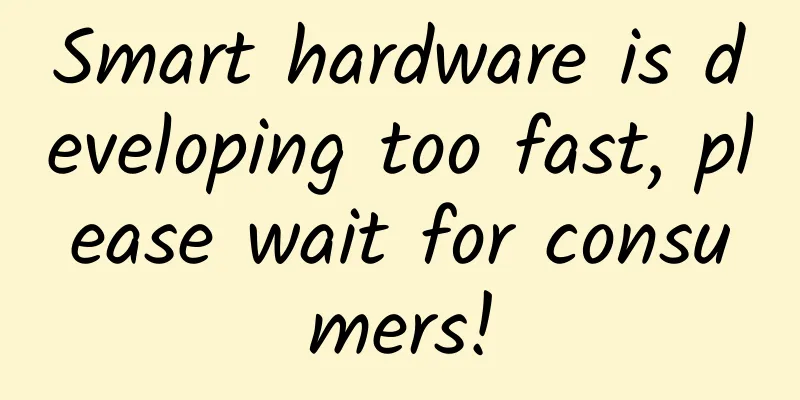Smart hardware is developing too fast, please wait for consumers!

|
2014 is coming to an end, and it is clear that investors have made great gains in terms of the number of projects invested in 2014. Based on limited information, I have sorted out that, especially for angel investors, the focus, waiting and following investment are almost concentrated in two areas: one is mobile Internet; the other is smart hardware. Why are they the two fields of mobile Internet and smart hardware? In fact, it is undeniable that smart hardware is the product of industrial evolution under the trend of mobile Internet. From this perspective, perhaps we can understand why investors are more enthusiastic about investing in mobile Internet than smart hardware, at least from the current investment situation. It is undeniable that investors who once invested in the Internet field chose to invest in mobile Internet without hesitation when mobile Internet came. I define this investment behavior and decision as the thinking path dependence of decision-making, that is, humans usually like to guide their thinking decisions based on their inherent experience. Because we have past experience with the Internet, we will unconsciously turn to mobile Internet through this thinking path dependence. If we define smart hardware strictly, it is obviously not the exclusive category of the Internet. The so-called use of Internet thinking to make products is essentially just a marketing concept, and this marketing concept can explode because of the trend. A more accurate definition of smart hardware should be a cross-border product, which is the product of the intersection of the boundaries of mobile Internet and traditional manufacturing. Because smart hardware is the product of the intersection of traditional manufacturing and mobile Internet, the thinking path we are used to is in a fuzzy zone. For the Internet and traditional manufacturing, two giants that used to be thriving in their respective fields and did not have much intersection, they are relatively unfamiliar with each other and have no in-depth interaction. At this time, mobile Internet suddenly stepped in, with one foot on the Internet and the other on traditional manufacturing, so a third boundary industry appeared outside the two major fields of Internet and traditional manufacturing, that is, the smart hardware industry. This intersection of boundaries makes entrepreneurs in the two major fields of the Internet and traditional manufacturing feel that smart hardware seems to be closely related to their own industries. In the eyes of practitioners in the traditional manufacturing industry, it seems that as long as it leans a little to the right, it is smart hardware. In other words, it can be achieved by adding some smart elements such as chips, sensors, APP control, etc. to the advantages of the original products through research and development. Similarly, for practitioners in the Internet field, it seems that as long as they lean a little to the left, they will have smart hardware. That is, by leveraging the existing Internet user groups, or the research experience on Internet users, and then integrating and transforming the traditional manufacturing industry, adding mobile control elements, it seems that smart hardware in the mobile Internet era is born. Of course, there is a third group of people, that is, some start-ups who see that the cross-border industry of smart hardware is only one step away. So they seize this new business wave by forming a cross-border team. But from today's reality, whether it is the Internet field, traditional manufacturing, or entrepreneurial groups, they are all busy in the smart hardware industry. But the other end of the market, that is, consumers, seem indifferent, and the smart hardware industry can be described as ice and fire. This phenomenon has made investors even more confused. Since the second half of this year, some investors have chosen to wait and see the smart hardware industry. Some people may think that the smart hardware industry is a pit. For example, the currently popular smart bulbs, smart sockets, smart bicycles and other products have almost no practical use value, and are more of a self-appreciative technological toy. For example, the smart socket, which seems to be a beautiful smart product, can control the switch of the electrical appliances at home through the mobile phone, which seems very smart. Thinking deeply, this product does not have much actual value in my opinion. If we want to solve the control problem of electrical equipment, then the electrical equipment manufacturers can completely achieve it by loading their own APP without adding such an extra accessory; if the traditional socket manufacturer directly integrates the smart control chip into the wall switch socket, and then loads the built-in APP, it is not simpler and more convenient; if it is to solve the switch control problem, perhaps the traditional button switch is more convenient, because we only need to press the switch on the socket directly, without taking out the mobile phone, then opening the APP, and then selecting the socket to be controlled, and then operating it. I give this example to tell you that the current situation of smart hardware is a bit delicate. Many seemingly smart products are more valuable than their actual use. From this perspective, smart hardware has indeed dug several pitfalls for investors. In my opinion, the reasons for these pitfalls are mainly the following: First, some young entrepreneurial teams lack insight and understanding of the actual needs of users, and lack the industry experience of traditional manufacturing. It is very important to understand and master the knowledge accumulated in these industries, which cannot be obtained by searching for some articles or reports on the Internet, or some industry analysis data. Because if we want to subvert some products of traditional industries with the help of mobile Internet, we need to have an in-depth understanding of the formation of traditional industries and the reasons and problems of their products. Only at this time can innovation avoid the misunderstanding of self-indulgence. Second, for Internet companies, when entering the real world from a virtual world, they should not subvert for the sake of subversion, but should truly design products that can bring practical use value to users. This is not a simple combination of Internet concepts and supply chains. Although some Internet models are beautiful, entering the real industry requires a deeper understanding because these products are civilian products. There are differences in the use attributes, performance requirements, and usage characteristics of civilian products and smart phone products. Therefore, for Internet companies to enter, smart hardware gives the tools of the virtual world of the Internet a fuller body. And this body is not just a one-night stand for users, but a woman who can both be in the living room and in the kitchen, beautiful and graceful, wise and virtuous, and of course, more importantly, can also give birth to children, wash clothes, and cook. Such smart hardware is the real demand of users. 3. For traditional manufacturing, most decisions are made in accordance with the path dependence of thinking and Moore's Law to explore the upgrading space in the industry. Obviously, they have no experience in cross-border things such as smart hardware. Especially for traditional manufacturing, which lacks Internet genes, facing the sudden smart hardware riding the fast horse of mobile Internet, they seem to be a little confused. Obviously, the industrial upgrading method that followed Moore's Law in the past is difficult to adapt to this cross-border product. Whether it is traditional enterprises, Internet enterprises, or new entrepreneurs, there is no clear rule to follow in the field of smart hardware. For users, it seems that they want to own smart hardware, but they feel that it has little practical value. For investors, it seems that every startup report has a huge room for disruption. From 2013 to 2014, looking forward to 2015, it seems that they are still destined to continue to invest. When will this pit be filled? Is smart hardware a blessing or a curse for investors? Thinking and observing this question rationally, we find that although concepts such as smart home appliances and smart homes are not new terms, we have to admit that smart hardware, which came with the mobile Internet, is still a young child. Especially after Google acquired Nest, the smart hardware craze swept across the ocean to China. With the help of the trend of mobile Internet, capital, talents, media, and entrepreneurs poured in. Various alliances, organizations, salons, conferences, and roadshows were overwhelming. In particular, the smart hardware products on various roadshows were aggressive in subverting the industry and creating new markets. The business model, marketing model, product technology, etc. all had seemingly clear plans, but it was obvious that today they did not achieve the expected goals. This is actually a very normal thing in my opinion. Just as I described in another article I published recently, " Have Wearable Devices Set Trap Investors? ", smart hardware is also an emerging technology star. When the entire industrial chain is not yet sound, the business model is not yet clear, and the public does not have a clear understanding, the entire smart hardware industry has already entered the road of commercial exploration. This has led to the dislocation situation we see today. This does not mean that there is something wrong with the smart hardware industry, or that it is a wrong industry. On the contrary, smart hardware is the next round of trending industry, and it is the only industry in the mobile Internet era that can give the mobile Internet physical attributes. The core problem of this misalignment phenomenon is that the speed of entrepreneurs in the smart hardware field is faster than the development speed of the industry chain and the speed of user understanding. Before 2014, the industry chain of smart hardware was not mature. There were no specialized chips, sensors, and communication technologies. Cloud platforms and big data were not effectively supported. The entire industry chain was more of a conceptual focus, but no actual action was taken. This obviously made it difficult to support the commercialization of the smart hardware industry. In 2014, with the advancement of major giants, their value did not lie in driving the direction and bringing confidence, but in driving the actual actions of the industry chain and the attention of users. Believe it or not, the trend of smart hardware in 2015 will be more exciting. Investors will soon climb out of this pit and stand on the cusp of the trend with the help of the wave of mobile Internet. I make this judgment mainly based on the following reasons: First, consumers are becoming more and more accepting of smart hardware products, and they will be more inclusive of smart hardware products; second, for smart hardware entrepreneurs, no matter which dimension of manufacturers, after experiencing the enthusiasm and confusion in 2014, they will have more mature thinking about the commercialization of the smart hardware industry; third, the specialization and segmentation of the industrial chain will provide support for the development of the smart hardware industry; fourth, the entry of technology giants provides a guarantee for the construction of the system platform of the smart hardware industry, which will change the situation of "each doing its own thing" in the traditional manufacturing industry, and all smart hardware will be standard products. As for the development trend of the entire smart hardware industry in 2015, or its technological direction, I think it will be mainly in the following six aspects: 1. APP will be standardized and platformized. Soon, an APP system similar to the Android system will appear, and all smart hardware manufacturers will conduct secondary development and application based on a system platform. For users, no matter how many smart hardware products we have, our mobile phones will no longer have a variety of APP applications, but a super APP, or an APP manager. 2. The system platform will be built and opened. Whether it is Google, Apple, Samsung, Haier, etc., their system platforms for different smart hardware will be open to developers. The opening of the smart hardware system platform is also quite different from Apple's previous app store. The developer platform previously opened based on mobile phones was only based on the operation and development of application software. The opening of the system platform based on smart hardware will no longer be limited to a single software level, but two sections will be opened at the same time, that is, the opening of the hardware interface, or the hardware access standard, and the opening of the application software operation level. 3. All smart hardware will be standardized products. The difference from the standardization of traditional manufacturing products is that smart hardware based on the system platform will become a standardized product. In addition to the test indicators of the product performance itself, the most important thing that unifies the standard is the interface standard opened by the system platform. For the system platform, as long as it is smart hardware that meets its system interface standards, whether it is chopsticks, bicycles, toilets, mattresses, air purifiers, sockets, light bulbs, etc., it is just a component for the ecosystem of the system platform. 4. Hardware interface standards will be unified. Whether it is online data transmission or charging of smart hardware, as long as the hardware ports required for the smart hardware itself are connected, they will tend to be unified. At the same time, for smart hardware products with the same voltage standard, their chargers will also tend to be unified. 5. The boundaries of industries will become blurred. Whether it is entrepreneurs, Internet companies, or traditional manufacturing, they are just a supporting role, or a "component" in the ecosystem created by the cross-border industry of smart hardware. Therefore, the definition of industries will become more and more blurred, and there will be more integration. There is no such thing as who subverts whom, but who can develop better products to serve users. 6. Wireless communication will become a standard module. Whether it is through a home control center, or transmitted separately, or to achieve interconnection and interaction between different smart hardware, it will be based on wireless communication technology. At this time, wireless communication technology will become a standard configuration or accessory for each smart hardware product in a modular way. As a winner of Toutiao's Qingyun Plan and Baijiahao's Bai+ Plan, the 2019 Baidu Digital Author of the Year, the Baijiahao's Most Popular Author in the Technology Field, the 2019 Sogou Technology and Culture Author, and the 2021 Baijiahao Quarterly Influential Creator, he has won many awards, including the 2013 Sohu Best Industry Media Person, the 2015 China New Media Entrepreneurship Competition Beijing Third Place, the 2015 Guangmang Experience Award, the 2015 China New Media Entrepreneurship Competition Finals Third Place, and the 2018 Baidu Dynamic Annual Powerful Celebrity. |
<<: Smart home five-year outlook: big data and greater security
>>: Stop worrying about Google Glass
Recommend
Loneliness is as harmful as smoking 15 cigarettes a day. It has become a global public health problem! Is there an antidote?
Author: Duan Yuechu Loneliness is a feeling of in...
iOS 14.5 official version is here: 13 new features updated, 12 bugs fixed
After nearly three months of continuous improveme...
Chengdu and Chongqing: Dinosaurs are everywhere
The Sichuan Basin lies between Chengdu and Chongq...
iOS 13 Beta 4: 5 new changes worth noting
Apple has released the fourth iOS 13 developer be...
Case! “User incentive” routine fails? See how others do it
Now that you have users, what next? In the past t...
Does the world need Xiaomi?
Celebrity appearances, live streams by internet c...
[Practical] How to create a Facebook ad?
Many newbies have just come into contact with Fac...
The latest APP listing guide for each app store!
The current domestic traffic is becoming increasi...
Learn mathematical modeling and MATLAB programming in 7 days
Course Description This course requires a certain...
WeChat 8.0.2 is now available! New visitor permissions and 7 new changes
Recently, Apple iOS WeChat released version 8.0.2...
How to promote and attract traffic to Xianyu? The practical method of attracting traffic to Xianyu with coupons is revealed!
Xianyu is now a traffic-generating platform that ...
Apple accepted Qualcomm's offer to launch a 5G iPhone this year, but only if the licensing fee is reasonable.
Apple is willing to cooperate with Qualcomm again...
What do Arctic methane bursts mean? What impacts will it have?
The Arctic methane burst refers to the fact that ...
Joining the smart hardware battlefield, what attracts PPTV mobile phones
More and more Internet companies are joining the ...
Top 10 SaaS Product Operation Trends in 2021
Many companies and businesses came to a standstil...









